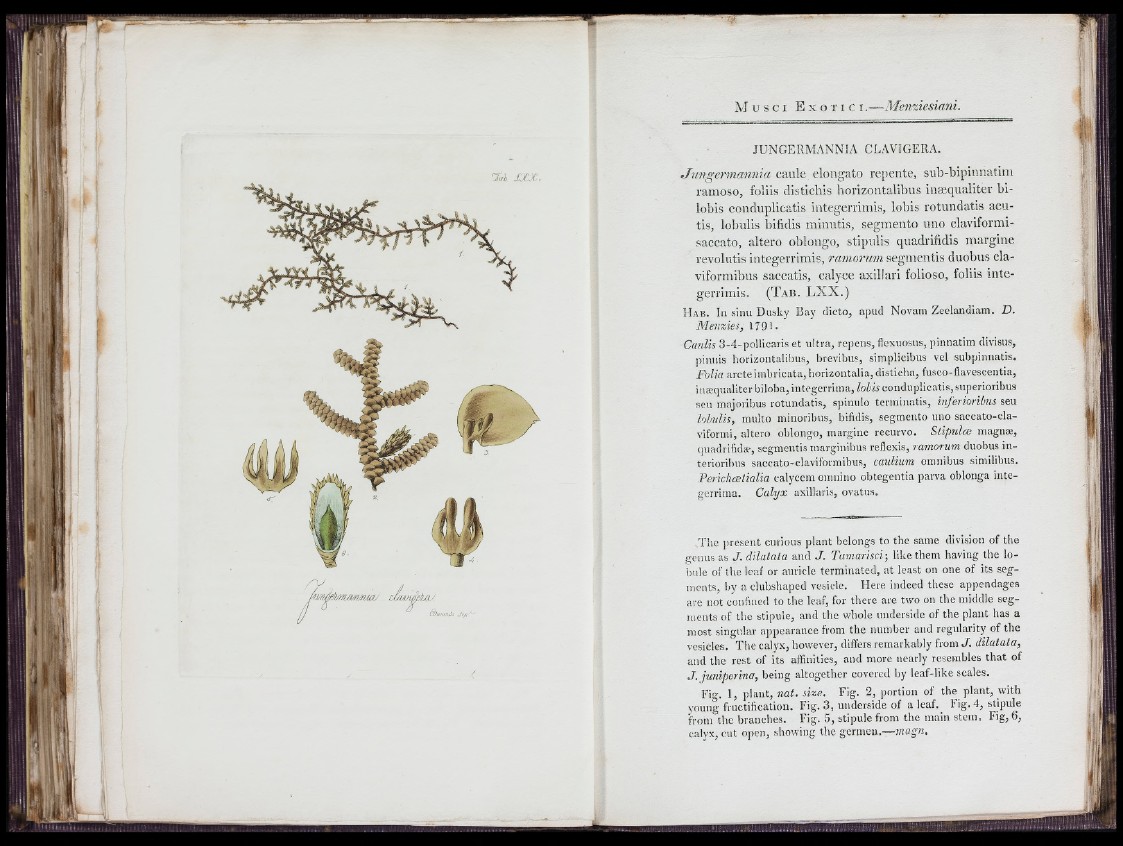
Tal JXr
/ y
•hmm/mo rJw i
CiAu/iiAàj Jc/t
J UNGE RMANNIA CLAVI GERA.
J n n g e n n a n n ia c aule e lo n g a to re p e n te , s iib -b ip in n a tiin
ram o so , foliis d istich is h o riz o n ta lib u s inæ q u a lite r b ilobis
co n d u p lic a tis in te g e rrim is, lobis ro tu n d a tis a cu tis,
lobulis bifidis m ln u tis , se gm e n to u n o claviformi-
saccato, a lte ro oblongo, stip u lis qu ad rifid is m a rg in e
rev o lu tis in te g e rrim is , ram o rum s egm en tis du o b u s cla-
v ifo rin ib u s saccatis, calyce ax illa rl folioso, foliis in te g
e rrim is. (T a b . L X X .)
H ab. In sinu Dusky Bay dicto, apud Novam Zeelandiam. D .
Menzies, 179 !•
Canlis .3-4-pollicaris et ultra, repens, flexuosus, pinnatim divisus,
))iuuis horizontalibus, brevibus, simpiicibus vel subpinnatis.
Folia arcte imbricata, horizontalia, disticha, fusco-flavescentia,
iuæqualiterbiloba,integerrima, Zo¿ijcondup!icatis,superioribus
seu majoribus rotundatis, spinalo terminatis, inferioribus seu
loìndis, multo minoribus, bifidis, segmento uno saccato-cla-
viformi, altero oblongo, margine recurvo. Stipules magnæ,
quadrifida*, segmentis marginibus reflexis, ramorum duobus in-
terioribus saccato-claviformibus, caidium omnibus similibus.
Perichoelialia calycem omnino obtegentia parva oblonga integerrima.
Calyx axillaris, ovatus.
The ])resent curious plant belongs to the same division of the
genus as J . dilataia and J . Tamarisci; like them having the lobule
of the leaf or auricle terminated, at least on one of its segments,
by a clubshaped vesicle. Here indeed these appendages
are not confined to the leaf, for there are two on the middle segments
of the stipule, and the whole underside of the plant has a
most singular appearance from the number and regularity of the
vesicles. The calyx, however, differs remarkably from J. dilataia,
and the rest of its affinities, and more nearly resembles that of
J , juniperina, being altogether covered by leaf-like scales.
Fi»-. 1, nat. size. Fig. 2, portion of the plant, with
young fructification. Fig. 3, underside of a leaf. Fig.4, stipuly
■from the branches. Fig. 5, stipule from the main stem. Fig, 6,
calyx, cut open, showing the genneu.—